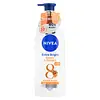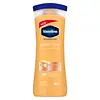Nivea Extra Bright Repair & Protect Body Lotion SPF 30 PA++ Versus Vaseline Intensive Care Even Tone Body Lotion
What's inside
What's inside
 Key Ingredients
Key Ingredients

 Benefits
Benefits

 Concerns
Concerns

 Ingredients Side-by-side
Ingredients Side-by-side

Water
Skin ConditioningOctocrylene
UV AbsorberSodium Phenylbenzimidazole Sulfonate
UV AbsorberC12-15 Alkyl Benzoate
AntimicrobialButyl Methoxydibenzoylmethane
UV AbsorberGlycerin
HumectantCyclomethicone
EmollientDistarch Phosphate
AbsorbentPolyglyceryl-3 Methylglucose Distearate
EmulsifyingAlcohol Denat.
AntimicrobialCetyl Alcohol
EmollientUbiquinone
AntioxidantGlycyrrhiza Glabra Root Extract
BleachingSodium Ascorbyl Phosphate
AntioxidantMyrciaria Dubia Fruit Juice
AntioxidantMalpighia Glabra Fruit Juice
Skin ConditioningGlyceryl Glucoside
HumectantPropylene Glycol
HumectantTrideceth-9
EmulsifyingSodium Carbomer
Emulsion StabilisingHydroxyethylcellulose
Emulsion StabilisingSodium Polyacrylate
AbsorbentTrisodium EDTA
Citric Acid
BufferingPhenoxyethanol
PreservativeMethylparaben
PreservativeEthylparaben
PreservativePropylparaben
PreservativeBenzoic Acid
MaskingLinalool
PerfumingGeraniol
PerfumingLimonene
PerfumingBenzyl Alcohol
PerfumingCitronellol
PerfumingParfum
MaskingWater, Octocrylene, Sodium Phenylbenzimidazole Sulfonate, C12-15 Alkyl Benzoate, Butyl Methoxydibenzoylmethane, Glycerin, Cyclomethicone, Distarch Phosphate, Polyglyceryl-3 Methylglucose Distearate, Alcohol Denat., Cetyl Alcohol, Ubiquinone, Glycyrrhiza Glabra Root Extract, Sodium Ascorbyl Phosphate, Myrciaria Dubia Fruit Juice, Malpighia Glabra Fruit Juice, Glyceryl Glucoside, Propylene Glycol, Trideceth-9, Sodium Carbomer, Hydroxyethylcellulose, Sodium Polyacrylate, Trisodium EDTA, Citric Acid, Phenoxyethanol, Methylparaben, Ethylparaben, Propylparaben, Benzoic Acid, Linalool, Geraniol, Limonene, Benzyl Alcohol, Citronellol, Parfum
Water
Skin ConditioningGlycerin
HumectantIsopropyl Myristate
EmollientStearic Acid
CleansingGlyceryl Stearate
EmollientParaffinum Liquidum
EmollientEthylhexyl Methoxycinnamate
UV AbsorberNiacinamide
SmoothingTriethanolamine
BufferingDimethicone
EmollientPhenoxyethanol
PreservativeButyl Methoxydibenzoylmethane
UV AbsorberParfum
MaskingCarbomer
Emulsion StabilisingMethylparaben
PreservativeTitanium Dioxide
Cosmetic ColorantCetyl Alcohol
EmollientGlutamic Acid
HumectantSodium PCA
HumectantPropylparaben
PreservativePetrolatum
EmollientSodium Hydroxide
BufferingDisodium EDTA
Hydrated Silica
AbrasiveAluminum Hydroxide
EmollientAlginic Acid
Skin ConditioningBHT
AntioxidantSodium Carbonate
BufferingXanthophylls
Skin ConditioningSodium Chloride
MaskingBenzyl Alcohol
PerfumingBenzyl Salicylate
PerfumingCitronellol
PerfumingCitrus Aurantium Peel Oil
Citrus Limon Peel Oil
MaskingGeraniol
PerfumingGeranyl Acetate
PerfumingHexyl Cinnamal
PerfumingHydroxycitronellal
PerfumingLimonene
PerfumingLinalool
PerfumingLinalyl Acetate
MaskingPinene
MaskingTerpineol
MaskingWater, Glycerin, Isopropyl Myristate, Stearic Acid, Glyceryl Stearate, Paraffinum Liquidum, Ethylhexyl Methoxycinnamate, Niacinamide, Triethanolamine, Dimethicone, Phenoxyethanol, Butyl Methoxydibenzoylmethane, Parfum, Carbomer, Methylparaben, Titanium Dioxide, Cetyl Alcohol, Glutamic Acid, Sodium PCA, Propylparaben, Petrolatum, Sodium Hydroxide, Disodium EDTA, Hydrated Silica, Aluminum Hydroxide, Alginic Acid, BHT, Sodium Carbonate, Xanthophylls, Sodium Chloride, Benzyl Alcohol, Benzyl Salicylate, Citronellol, Citrus Aurantium Peel Oil, Citrus Limon Peel Oil, Geraniol, Geranyl Acetate, Hexyl Cinnamal, Hydroxycitronellal, Limonene, Linalool, Linalyl Acetate, Pinene, Terpineol
Ingredients Explained
These ingredients are found in both products.
Ingredients higher up in an ingredient list are typically present in a larger amount.
Benzyl Alcohol is most commonly used as a preservative. It also has a subtle, sweet smell. Small amounts of Benzyl Alcohol is not irritating and safe to use in skincare products. Most Benzyl Alcohol is derived from fruits such as apricots.
Benzyl Alcohol has both antibacterial and antioxidant properties. These properties help lengthen the shelf life of products. Benzyl Alcohol is a solvent and helps dissolve other ingredients. It can also improve the texture and spreadability.
Alcohol comes in many different forms. Different types of alcohol will have different effects on skin. This ingredient is an astringent alcohol.
Using high concentrations of these alcohols are drying on the skin. They may strip away your skin's natural oils and even damage your skin barrier. Astringent alcohols may also irritate skin.
Other types of astringent alcohols include:
According to the National Rosacea Society based in the US, you should be mindful of products with these alcohols in the top half of ingredients.
Any type of sanitizing product will have high amounts of alcohol to help kill bacteria and viruses.
Learn more about Benzyl AlcoholAlso known as Avobenzone, this ingredient is a chemical sunscreen filter that provides protection in the UV-A range.
Avobenzone is globally approved and is the most commonly used UV-A filter in the world.
Studies have found that avobenzone becomes ineffective when exposed to UV light (it is not photostable; meaning that it breaks down in sunlight). Because of this, formulations that include avobenzone will usually contain stabilizers such as octocrylene.
However, some modern formulations (looking at you, EU!) are able to stabilize avobenzone by coating the molecules.
Avobenzone does not protect against the UV-B range, so it's important to check that the sunscreen you're using contains other UV filters that do!
The highest concentration of avobenzone permitted is 3% in the US, and 5% in the EU.
Learn more about Butyl MethoxydibenzoylmethaneCetyl Alcohol is a fatty alcohol. Fatty Alcohols are most often used as an emollient or to thicken a product.
Its main roles are:
Though it has "alcohol" in the name, it is not related to denatured alcohol or ethyl alcohol.
The FDA allows products labeled "alcohol-free" to have fatty alcohols.
Learn more about Cetyl AlcoholCitronellol is used to add fragrance/parfum to a product. It is often derived from plants such as roses. In fact, it can be found in many essential oils including geranium, lavender, neroli, and more. The scent of Citronellol is often described as "fresh, grassy, and citrus-like".
Since the Citronellol molecule is already unstable, Citronellol becomes irritating on the skin when exposed to air.
Citronellol is a modified terpene. Terpenes are unsaturated hydrocarbons found in plants. They make up the primary part of essential oils.
Citronellol is not able to be absorbed into deeper layers of the skin. It has low permeability,
Citronellol is also a natural insect repellent.
Learn more about CitronellolGeraniol is used to add fragrance/parfum to a product. It is the main component of citronellol. It is a monoterpenoid and an alcohol.
Monoterpenes are naturally found in many parts of different plants.
Geraniol can be found in many essential oils including Rose Oil and Citronella Oil. The scent of Geraniol is often described as "rose-like". Many foods also contain Geraniol for fruit flavoring.
Geraniol can irritate the skin when exposed to air. However, irritation depends on the ability of geraniol to penetrate into the skin. In general, geraniol is not able to penetrate skin easily.
Geraniol is colorless and has low water-solubility. However, it is soluble in common organic solvents.
Like citronellol, it is a natural insect repellent.
2,6-Octadien-1-ol, 3,7-dimethyl-, (2E)-
Learn more about GeraniolGlycerin is already naturally found in your skin. It helps moisturize and protect your skin.
A study from 2016 found glycerin to be more effective as a humectant than AHAs and hyaluronic acid.
As a humectant, it helps the skin stay hydrated by pulling moisture to your skin. The low molecular weight of glycerin allows it to pull moisture into the deeper layers of your skin.
Hydrated skin improves your skin barrier; Your skin barrier helps protect against irritants and bacteria.
Glycerin has also been found to have antimicrobial and antiviral properties. Due to these properties, glycerin is often used in wound and burn treatments.
In cosmetics, glycerin is usually derived from plants such as soybean or palm. However, it can also be sourced from animals, such as tallow or animal fat.
This ingredient is organic, colorless, odorless, and non-toxic.
Glycerin is the name for this ingredient in American English. British English uses Glycerol/Glycerine.
Learn more about GlycerinLimonene is a fragrance that adds scent and taste to a formulation.
It's found in the peel oil of citrus fruits and other plants such as lavender and eucalyptus. The scent of limonene is generally described as "sweet citrus".
Limonene acts as an antioxidant, meaning it helps neutralize free radicals.
When exposed to air, oxidized limonene may sensitize the skin. Because of this, limonene is often avoided by people with sensitive skin.
The term 'fragrance' is not regulated in many countries. In many cases, it is up to the brand to define this term. For instance, many brands choose to label themselves as "fragrance-free" because they are not using synthetic fragrances. However, their products may still contain ingredients such as essential oils that are considered a fragrance.
Learn more about LimoneneLinalool is a fragrance and helps add scent to products. It's derived from common plants such as cinnamon, mint, citrus, and lavender.
Like Limonene, this ingredient oxidizes when exposed to air. Oxidized linalool can cause allergies and skin sensitivity.
This ingredient has a scent that is floral, spicy tropical, and citrus-like.
Learn more about LinaloolMethylparaben is a preservative and is a paraben. It is used to prevent the growth of fungus, mold, and other harmful bacteria. Parabens are chemicals used as preservatives in both cosmetics and food.
Methylparaben can be synthetically created. It can also be found naturally in some fruits, such as blueberries.
Oftentimes, Methylparaben is combined with other parabens to help increase the shelf life.
The safety of Methylparaben is currently being studied. While ongoing studies are looking into the safety of parabens, the results have been very mixed. Some studies have not found Methylparaben to be harmful.
Learn more about MethylparabenParfum is a catch-all term for an ingredient or more that is used to give a scent to products.
Also called "fragrance", this ingredient can be a blend of hundreds of chemicals or plant oils. This means every product with "fragrance" or "parfum" in the ingredients list is a different mixture.
For instance, Habanolide is a proprietary trade name for a specific aroma chemical. When used as a fragrance ingredient in cosmetics, most aroma chemicals fall under the broad labeling category of “FRAGRANCE” or “PARFUM” according to EU and US regulations.
The term 'parfum' or 'fragrance' is not regulated in many countries. In many cases, it is up to the brand to define this term.
For instance, many brands choose to label themselves as "fragrance-free" because they are not using synthetic fragrances. However, their products may still contain ingredients such as essential oils that are considered a fragrance by INCI standards.
One example is Calendula flower extract. Calendula is an essential oil that still imparts a scent or 'fragrance'.
Depending on the blend, the ingredients in the mixture can cause allergies and sensitivities on the skin. Some ingredients that are known EU allergens include linalool and citronellol.
Parfum can also be used to mask or cover an unpleasant scent.
The bottom line is: not all fragrances/parfum/ingredients are created equally. If you are worried about fragrances, we recommend taking a closer look at an ingredient. And of course, we always recommend speaking with a professional.
Learn more about ParfumPhenoxyethanol is a preservative that has germicide, antimicrobial, and aromatic properties. Studies show that phenoxyethanol can prevent microbial growth. By itself, it has a scent that is similar to that of a rose.
It's often used in formulations along with Caprylyl Glycol to preserve the shelf life of products.
Propylparaben is a preservative and is a paraben with antifungal and antimicrobial properties.
This ingredient can be naturally found in plants and insects, but most of it is synthetically manufactured for human use. In cosmetics, it is usually created by reacting para-aminobenzoic acid and propanol (an alcohol).
You can usually find this ingredient in water-based products.
Parabens have come under controversy due to the claim they are hormone disruptors. Studies show conflicting results. We recommend speaking with a professional if you have any concerns.
Propylparaben is commonly found in food, medicine, and cosmetics.
Learn more about PropylparabenWater. It's the most common cosmetic ingredient of all. You'll usually see it at the top of ingredient lists, meaning that it makes up the largest part of the product.
So why is it so popular? Water most often acts as a solvent - this means that it helps dissolve other ingredients into the formulation.
You'll also recognize water as that liquid we all need to stay alive. If you see this, drink a glass of water. Stay hydrated!
Learn more about Water